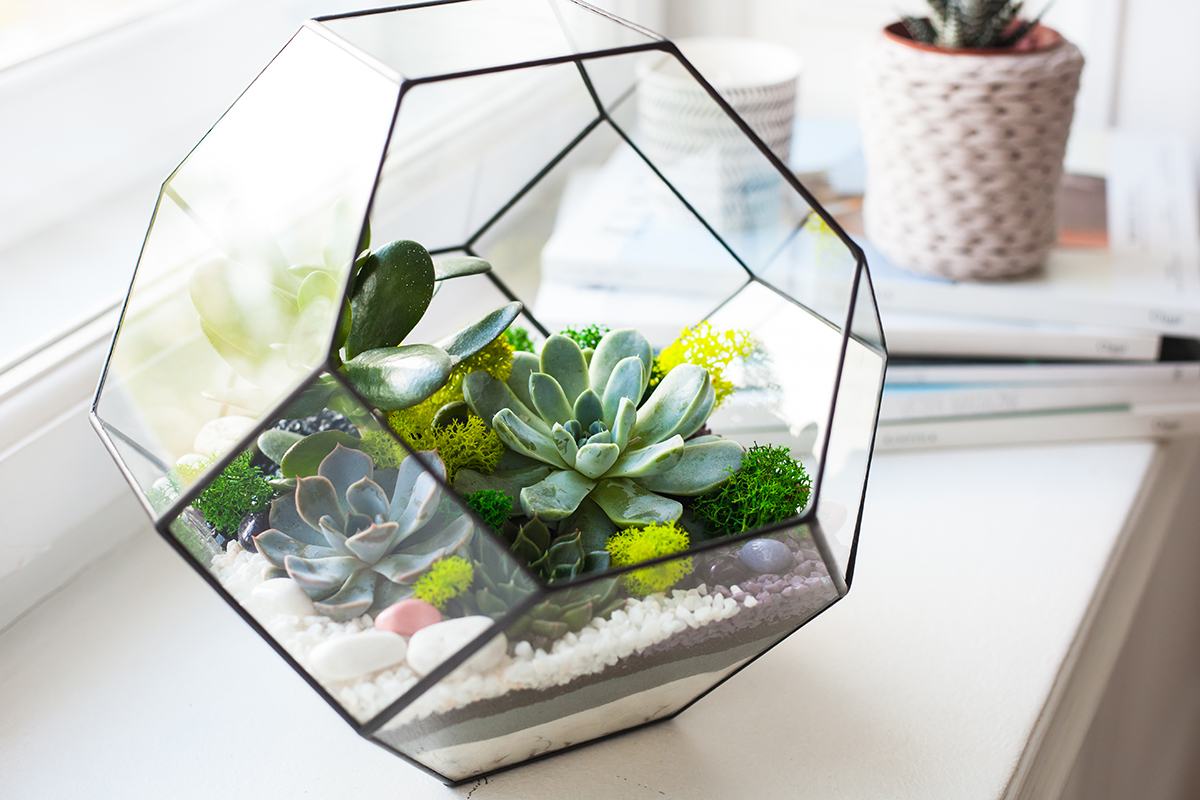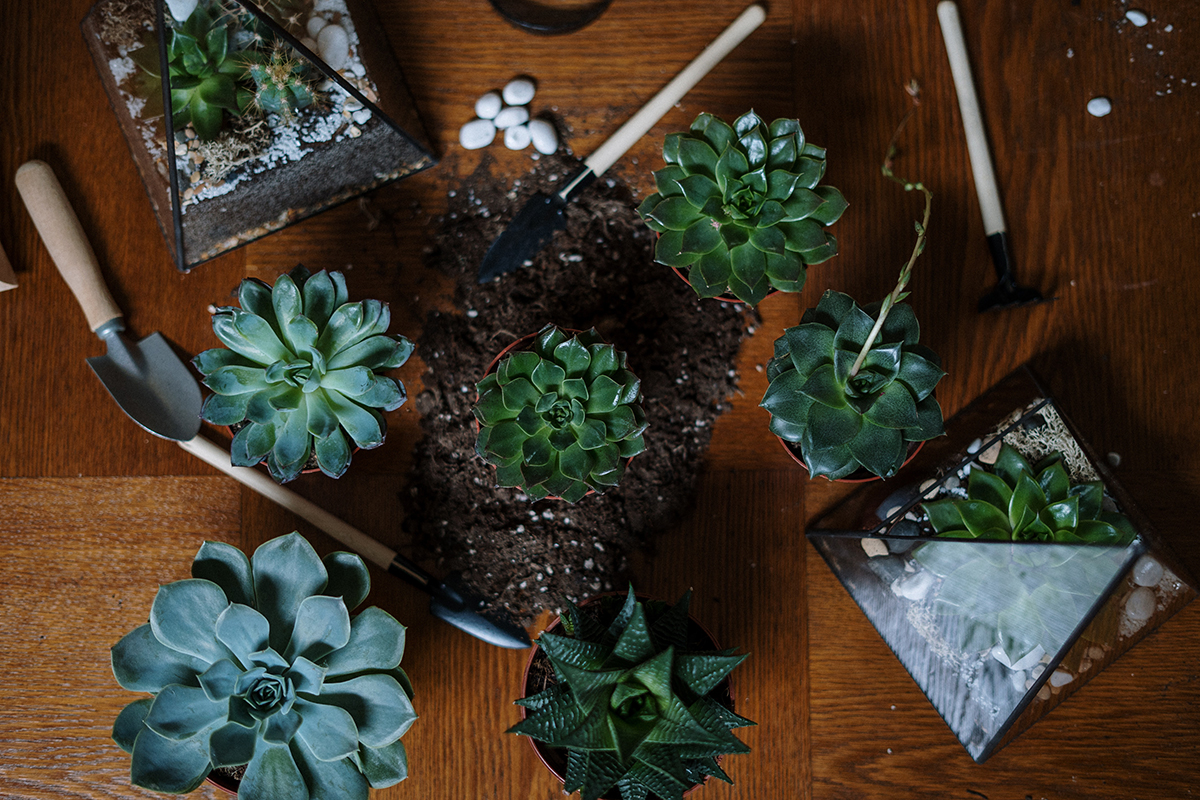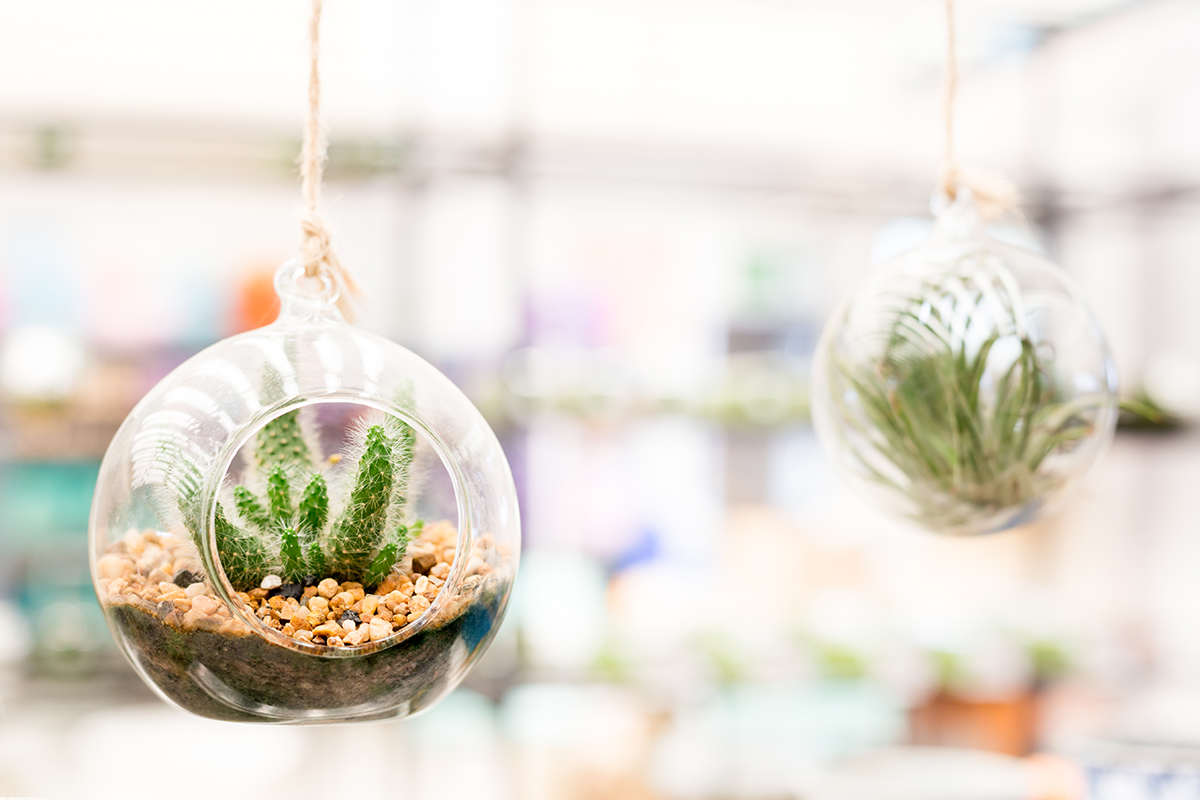Are you bored of your tabletop mini-greenhouse? Yes? You can try a hanging terrarium.
Now you worry about how to go about that. Well, we’ve got you.
This article contains the guide to set up your hanging mini-garden. Here, you will find what plants you should use.
More importantly, this piece also contains how to set up your swinging terrarium and where to hang it.
So, let’s create and hang magic. Shall we?
What Plants Fit A Hanging Terrarium?
First things first, that you hang your terrarium doesn’t mean it’s not still a regular. So, typical terrarium plants always work.
However, for the sake of beauty and low-maintenance routines, we’d advise that you settle for air plants and succulents.
Oh, wait! Add mosses too. They can be instrumental to your decoration aids.
Now, let’s take a look at the specifics and why they fit more into your hanging greenhouse.
Air Plants

Like the name indicates, air plants fit your hanging terrarium perfectly. For starters, these greens don’t need soil.
Furthermore, air plants (also called tillandsia) have special cells designed to cultivate nutrients and from the air. So, you see: they are the perfect match for a terrarium hanging in the air.
Fun fact: hanging terrariums are also called air plant terrariums.
Nonetheless, your air plants need water. Don’t apply too much. A little sprinkle is enough.
Here are some air plants you should consider:
- Cacticola
- Dyeriana
- Fuego
- Pink quill plant
- Sky Plant
Succulents

Succulents are somewhat different from air plants. Unlike the latter, the former doesn’t need frequent water.
In contrast, succulents can go a while without water. The reason for that is their fleshy and absorbent leaves. Those aids can store water for a long time.
For that reason, succulents make for hanged terrarium plants. That means you’d cut down on the need for routine watering.
Besides, succulents are beautiful plants.
That said, here are some succulents you can pick for your hanging mini-garden:
- Burro’s Tail
- Lithops
- Mini jade plants
- Tiger Jaws
- Zebra plant
Mosses

Hanged or tabletops, mosses have been a constant feature in terrariums. If there were to be a flagged terrarium plant, perhaps it’d be a moss.
Funnily enough, mosses are not technically plants. That makes them even more suitable for any terrarium.
And when you consider that hanged terrariums have less need for soil, mosses become even more vital. They can replace the substrates and yet add to the aesthetics of your hanging beauty.
However, you should note that the carpet mosses (pleurocarps) are the perfect fit here. See some examples that you should consider for your hanged mini-greenhouse:
- Fern moss
- Java moss
- Plume moss
- Sheet moss
- Shiny Seductive Moss
Now you know the common terrarium plants that fit your needs. Let’s see where to hang your delight.
Where Should You Hang Your Air Plant Terrarium?
Your Living Room
Your living room is one of the brightest spots in your home. It equally happens to entertain your guests. So, why not spice it up with entertaining air plants?
Your hanging mini-greenhouse could be that spice. For creativity, you can use wall extensions as hanging aids.
Your Kitchen
If you want to bring an aesthetic appeal to one of your favorite places, try an air plant terrarium. Imagine a rotating green amid all that sweet aromas!
That would be wowie, or what do you think?
Beautifully, you have numerous options in your kitchen. You could place the terrarium around your kitchen sink or even above your cabinets. Either way, you’d surely improve the beauty of your space.
Your Office
Plants generally improve the air around homes. And in an office space brimming with ideas, you’d need much of such atmosphere.
So, why not stylishly provide air with hanging terrariums?
For starters, you’ll improve your productivity. Also, you’d add a modern and stylish natural feel to your workspace.
Like your kitchens, you have options in your offices too. You can use your bookshelf area, walls, windows, or even above your computer.
Pleasurable ideas, huh? Would you like to add such delight to your living spaces? Yes?
See how below.
How To Create A DIY Hanging Terrarium?
Like any terrarium, the hanging type also requires some elements. Have a look at the specific ingredients you’d need:
- Glass containers – bulbs, globes, or jars
- Hangers – clamps, rope, and stands
- Water aids – misters or sprayers
- Planting substrate – mosses, potting mix, activated charcoal, and rocks
- Plants – you can also use cacti
- Decors
That said, let’s get handsy.

Set-up Your Base
Use glass containers. They are transparent and automatically add to your decor goals. Besides, with glass, it is easy to know how your plants are faring.
Next, add your plant substrate. We’d advise that you start with the stones. About that, maintain a ½ inch. That would be enough for an adequate drainage layer.
After, add your moss and activated charcoal. Make the combination at most ½ inch deep. By doing so, you would add a touch of beauty. More importantly, your maneuvers would help set a neutral-cum-detoxifying base for your plants.
Lastly, add the soil. Note that this phase isn’t compulsory. Most air plants would survive without soil.
So if at all you’d add soil, 1-2 inches would suffice. Even after that, you will still add another layer of moss.
Plant Your Greens
Once your planting base is complete, transfer your live plants to the mix. Be careful with the roots!
We’d advise that you use bare hands here. The reason for that is because the roots of air plants are delicate. So, try to be gentle.
Also, get enough soil as possible off the plants before transplanting them. Then, gently sit the transplant on your base.
Most importantly, remember that air plants have varying water needs. If you are planting typical tillandsia, a sprinkle is adequate.
On the other hand, succulents and mosses can handle a bit more water. Nevertheless, don’t overwater your plants.
Hanging And Maintenance
Your terrarium is ready. Now, you can hang it!
Don’t use glue. The reason is that when glued, maintaining your plants becomes more hectic.
Also, you can add a few decoration aids to bring more spice to your terrarium. Stones and figurines are great additions.
That’s all. Your beautification project is complete. Some magic, eh?
Mistakes To Avoid With Your Hanging Terrarium
The visuals that a hanging terrarium bring into any living space has to be one of the most exotic, yet authentic works of art that anyone can add to their home or office.
With how easy it is to make a terrarium, you must be champing at the bit to get yours going. Glamming up that space has been something weighing heavily on your mind, you just want to lay it to rest.
The object of your desire has been the hanging terrarium. However easy they look to get done, there are a few pitfalls that can prevent you from enjoying full benefits of the terrarium. Here are a few to consider.
Succulents in a closed terrarium.

That cactus looks stunning against the wall. What will it look like when it is hanging inside a beautiful glass orb?
The visual in your head has to be a beautiful one, but it is ultimately one that will frustrate you.
Succulents are excellent at fending off the heat and light of the sun, as well as the dry land’s attempts to suck it dry. This is a completely different environment to a closed terrarium in a cool and sheltered setting.
Succulents require great airflow if they are going to work in a terrarium. That means having an open terrarium, and one that is in direct light.
Get to know the plants you want.
Plants look perfect in their natural habitats. It’s only logical that you would want to have them in your home. However, those natural habitats have the perfect characteristics that allow the plant to thrive.
Not every plant will work in the type of hanging terrarium that you are looking to put up. If you are going for a closed terrarium, then it is best to find plants that thrive in a humid environment.
The opposite is true for open terrariums.
Too Much Light.

The thing about light from the sun is that it doesn’t just come on its own. It is an energy source that also comes with heat.
Before picking a plant, find out their light requirements. Most plants suitable for a terrarium do not require bright light. Attempting to place them in light might cause serious problems.
For one, the glass could act as a magnifier for the light that is coming in. If the hanging terrarium is closed, the humidity may also be an issue.
Too close to sources of heat.
Browsing the web for ideas for hanging terrariums will usually yield a number of exquisitely taken photos. A good number of those photos include terrariums that are hanging right above a fire place.
The heat from such close source could result in the plant slowly dying out. If it is closed, then you will basically be turning the terrarium into a sauna.
Not enough light.
As a cautious person, you may take notice of the effects that can be caused by having the hanging terrarium in the path of direct sunlight. To try and protect the plants, you place them in an area where light won’t easily reach them.
That is a problem.
Plants require light to perform photosynthesis. This is how plants get their food. Without sufficient light, your plants will slowly die out.
What you can do, instead, is place them in an area where they can get to enjoy light, but it doesn’t have to be direct. You can also utilize grow lights or liven the area with some fluorescent lights.
Too much water.
Pouring too much water in your house plant or garden can be very forgiving. When the soil soaks up the water that it needs, the rest will trickle further down into the ground. This leaves your plant with a sufficient amount for use.
That hanging terrarium will definitely not have drainage holes, and because you want your plants to prosper, you will use a watering can because you feel that is what is sufficient.
It is not.
Instead, you should use a spray bottle. In this way, you can accurately determine how much water you will be spraying into the terrarium.
Dirty Glass.
The beautiful thing about a terrarium is that it is a self-sustaining system. If you put in the right plant and hang the terrarium in that sweet spot, your plant will grow without needing to be watered as often.
This happens through transpiration, where the plant loses the water. However, since it is a closed system, the water will condense on the glass and slide back down into the terrarium.
This repeated action will see the glass slowly becoming dirty as the transpiration-condensation cycle repeats. This will result in foggy glass, obscuring the very thing you wanted to observe in the first place.
Cleaning that hanging terrarium is easy. Just use a damp piece of paper to wipe the glass clean, both inside and out. You can also use lint-free cloth to achieve the same results.
Remove dying plants.
It is safe to say that you may have to experience a few plant deaths before you get your terrarium working as it should.
As an agriculturalist, you may be tempted to let the plant die and provide mulch or nutrients to the other plants in the terrarium. This can be a terrible idea.
First, you don’t want the plant growing faster than it should. The whole purpose of a terrarium is to have small plants that fit into the container.
Also, the plant that is dead or dying could be as a result of an infection. If you let the dying plant stay inside with the others, then you risk that the infection killing this one plant will make its way to the others.
To remove them, you can use a small shovel, or a disused serving utensil. Do so carefully so as not to disturb the roots of the adjacent plants.
A hanging terrarium is a beautiful work of art in any home. It does take some work to keep them looking as glorious as they should be.




